 On June 1, 1813, two hundred and seven years ago today, the British frigate HMS Shannon defeated and captured the USS Chesapeake in single-ship combat. Captain James Lawrence on the Chesapeake was mortally wounded during the battle. His last words were, depending on the account, “Don’t give up the ship. Fight her till she sinks,” or “Tell them to fire faster; don’t give up the ship.” If “don’t give up the ship” was an order, it was impossible to follow and never carried out. The ship had already been taken by British boarders.
On June 1, 1813, two hundred and seven years ago today, the British frigate HMS Shannon defeated and captured the USS Chesapeake in single-ship combat. Captain James Lawrence on the Chesapeake was mortally wounded during the battle. His last words were, depending on the account, “Don’t give up the ship. Fight her till she sinks,” or “Tell them to fire faster; don’t give up the ship.” If “don’t give up the ship” was an order, it was impossible to follow and never carried out. The ship had already been taken by British boarders.
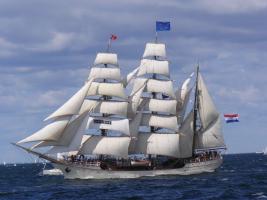 The bark Europa arrived in the port of Ushuaia, Argentina in late March. Ushuaia, which describes itself as “the end of the world, the beginning of everything,” would normally be the jumping-off point for the ship’s regular voyage to Antarctica. This year, however, the concurrent arrival of the Covid-19 pandemic changed everyone’s plans. The crew found themselves stuck aboard in port in pandemic limbo.
The bark Europa arrived in the port of Ushuaia, Argentina in late March. Ushuaia, which describes itself as “the end of the world, the beginning of everything,” would normally be the jumping-off point for the ship’s regular voyage to Antarctica. This year, however, the concurrent arrival of the Covid-19 pandemic changed everyone’s plans. The crew found themselves stuck aboard in port in pandemic limbo.
As reported by Newsweek, since there was no way on how to know when this world crisis would be finished, Dutch Captain Eric Kesteloo and his international sailing crew of 11 women and 8 men refused to sit and wait, and so they decided to sail back to Bark Europa‘s home harbor in Scheveningen, the Netherlands.
The Europa is currently completing the 10,000 mile non-stop voyage under sail back to her homeport. Marine Traffic reports that she departed Ushuaia on March 27 and is currently sailing east at 4.5 knots, with an estimated arrival in Scheveningen on June 16.
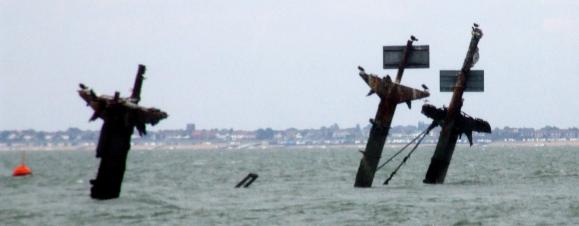 Three rusting masts rise from the Thames Estuary, off Sheppy Island, not far from Sheerness. They are the masts that once supported the swinging booms on the Liberty ship USS Richard Montgomery, which sank with a cargo of high explosive bombs and other munitions in 1944. The wreck still contains an estimated 1,400 tonnes of potentially highly volatile explosives. The remaining munitions are too dangerous to remove and also too dangerous to ignore.
Three rusting masts rise from the Thames Estuary, off Sheppy Island, not far from Sheerness. They are the masts that once supported the swinging booms on the Liberty ship USS Richard Montgomery, which sank with a cargo of high explosive bombs and other munitions in 1944. The wreck still contains an estimated 1,400 tonnes of potentially highly volatile explosives. The remaining munitions are too dangerous to remove and also too dangerous to ignore.
Now, the Ministry of Defence is offering to pay £5 million ‘danger money’ to any company prepared to hack off the rusting masts of the ship that the BBC has referred to as the “ticking time bomb of the Thames.” The concerns are that the rusting masts could waste away and fall onto the munitions, potentially causing a detonation.
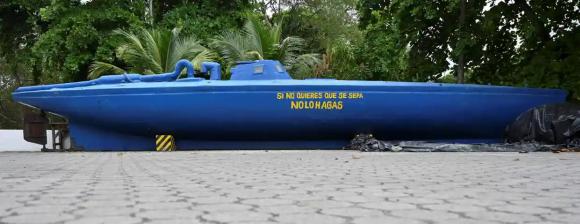
Narco-sub seized by Colombian Coast Guard — Photo: Guardian
In the 1990s, rumors began to spread that the Colombian cartels were moving cocaine to the United States by submarine. In 2006 the navy intercepted a “narco-sub” off Costa Rica with 3.5 tonnes of cocaine on board. In 2019, thirty-three submarines were intercepted by Colombian authorities, an average of almost three a month, most of them along the Pacific coast.
The Guardian quotes Admiral Hernando Enrique Mattos Dager, in charge of Colombia’s Poseidon taskforce against drug trafficking, saying, “Large quantities of cocaine are transported by sea,” he said. “It is much easier to move a tonne of cocaine by sea than by plane because there are more checks on freight at airports.” He estimates that 80% percent of the country’s illicit drugs leave via the Pacific coast and 14% go via the Caribbean.
On Throw-Back-Thursday, here is footage of the sinking of the German battleship Bismark, 79 years ago yesterday, by the Royal Navy in a three-day running battle in which the Bismark sank the British battlecruiser HMS Hood. Ultimately, the German battleship was disabled when her rudder was jammed in a torpedo attack by obsolescent Fairey Swordfish biplane torpedo bombers from the aircraft carrier HMS Ark Royal. Here is a British newsreel of the events. Thanks to Alaric Bond for contributing to this post.
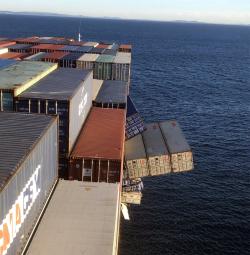
Photo:AMSA
It would appear to be a sign of times. Surgical masks have been washing ashore on the beaches of New South Wales, Australia. Not pandemic aid from King Neptune, but the result of containers of medical supplies among the at least 40 containers which were lost off the APL Europe in rough seas on Sunday.
The ship had been en route from Ningbo, China to Melbourne when the ship briefly lost propulsion and rolled violently in high seas. The rolling resulted in approximately 40 containers falling into the ocean southeast of Sydney, Australia. Following the loss, the 5,510 TEU Singapore-flagged vessel diverted to Brisbane. Continue reading
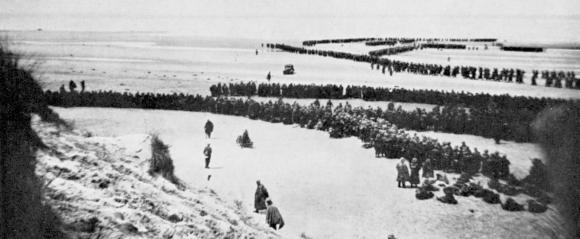 Eighty years ago today, on May 26, 1940, Operation Dynamo, the evacuation of British and other Allied troops from the French port of Dunkirk, began. Following a Blitzkrieg attack by German forces in early May, the British Expeditionary Force (BEF), three French field armies, and the remains of Belgian forces were driven back and encircled near Dunkirk. Initially, the plan was to attempt to rescue up to 45,000 troops. By June 4, when the Germans took the port, 338,000 British, French, and other Allied troops were evacuated across the English Channel to England.
Eighty years ago today, on May 26, 1940, Operation Dynamo, the evacuation of British and other Allied troops from the French port of Dunkirk, began. Following a Blitzkrieg attack by German forces in early May, the British Expeditionary Force (BEF), three French field armies, and the remains of Belgian forces were driven back and encircled near Dunkirk. Initially, the plan was to attempt to rescue up to 45,000 troops. By June 4, when the Germans took the port, 338,000 British, French, and other Allied troops were evacuated across the English Channel to England.
This year’s Fleet Week celebrations, traditionally held around the country over the Memorial Day weekend, have been canceled due to the pandemic. So, here is a Fleet Week New York flashback, the Parade of Ships from 2011. We hope that everyone has a happy, safe, and healthy Memorial Day weekend.
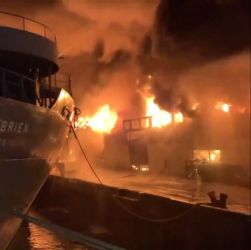 A major fire broke out on Saturday morning in a warehouse on Pier 45 on San Francisco’s Fisherman’s Wharf which came very close to the engulfing the historic World War II Liberty ship, SS Jeremiah O’Brien. The fire was reported at around 4:15 AM and quickly rose to four-alarms. At the height of the fire there were 130 firefighters and 50 apparatus on the scene.
A major fire broke out on Saturday morning in a warehouse on Pier 45 on San Francisco’s Fisherman’s Wharf which came very close to the engulfing the historic World War II Liberty ship, SS Jeremiah O’Brien. The fire was reported at around 4:15 AM and quickly rose to four-alarms. At the height of the fire there were 130 firefighters and 50 apparatus on the scene.
Shortly after the first firetrucks arrived, the San Francisco Fire Boat #3, St. Francis, also came on the scene. CBS San Francisco quotes fire department spokesman Lt. Jonathan Baxter who said that the fireboat crew saved the historic Liberty ship.
“When firefighters arrived, the flames were literally lapping over the Jeremiah O’Brien,” he said. “They literally saved the O’Brien.”
“The Jeremiah O’Brien has been known as the lucky ship,” said ship captain Cevan Lesieur. “She survived the North Atlantic and D-Day and that’s the first reaction — it’s a miracle!” Continue reading
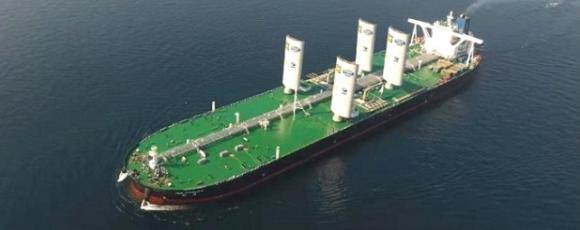 China Merchants Group has recently signed a contract with China Shipbuilding for two Very Large Crude Carriers (VLCCs) that will sail, powered, in part, by the wind while gliding on a cushion of air bubbles.
China Merchants Group has recently signed a contract with China Shipbuilding for two Very Large Crude Carriers (VLCCs) that will sail, powered, in part, by the wind while gliding on a cushion of air bubbles.
The two 300,000 DWT tankers will feature four rigid wing sails to provide wind-assisted propulsion. These ships will not be the first VLCCs with wing sails. In November 2018, China Merchants took delivery of New Vitality, a 300,000 DWT tanker with two rigid wing sails. The sail-assist provided on the New Vitality must have been successful, as the new ships will have double the number of wing sails of their near sister vessel.
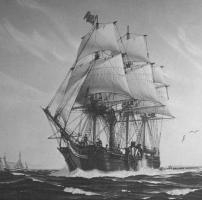 In the United States, May 22nd is celebrated as National Maritime Day. The day brings to mind a largely forgotten monument, a ship’s anchor on a concrete slab, on Corlear’s Hook in New York’s East River Park.
In the United States, May 22nd is celebrated as National Maritime Day. The day brings to mind a largely forgotten monument, a ship’s anchor on a concrete slab, on Corlear’s Hook in New York’s East River Park.
National Maritime Day was created by Congress in 1933 in honor of the sailing of the steam auxiliary packet ship Savannah sailing from her namesake city in 1819. Built as a sailing packet ship, the Savannah was outfitted with a 90 HP steam engine which drove twin paddle wheels and is credited as the first ship to cross the Atlantic under steam. The claim is a bit of a stretch, as she used her engine for 80 hours in a voyage of 29 days and 11 hours on the eastbound voyage across the Atlantic. On the westbound voyage, which lasted 40 days, she did not use her engines at all. Nevertheless, she was a technological marvel in her day. Unfortunately, Savannah was not an economic success and the steam engine was removed after her first voyage.
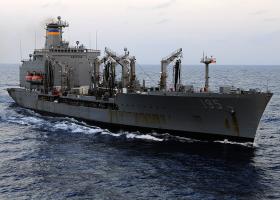 The latest coronavirus outbreak on a Navy ship is on the Military Sealift Command’s (MSC) fleet replenishment oiler, USNS Leroy Grumman. The Project On Government Oversight (POGO) is reporting that the outbreak occurred late last month, barely a week after the MSC assured the public that the coronavirus was not spreading among civilian mariners.
The latest coronavirus outbreak on a Navy ship is on the Military Sealift Command’s (MSC) fleet replenishment oiler, USNS Leroy Grumman. The Project On Government Oversight (POGO) is reporting that the outbreak occurred late last month, barely a week after the MSC assured the public that the coronavirus was not spreading among civilian mariners.
Twenty-two of the 46 civilian crew members and 30 government contractors have tested positive for the coronavirus. One contractor has been reported to have died from COVID-19 while one merchant mariner has been hospitalized in critical condition.
Whether in quarantine or not, the Monterey Bay Aquarium live shark cam is a great spot to escape to. The cam features sevengill sharks, leopard sharks, spiny dogfish, and the elusive Pacific angel shark in an aquarium that replicates the Monterey Bay habitat. Designed with sharks in mind, the exhibit’s 90-foot-long hourglass shape gives the big sharks room to glide and turn. If you watch carefully, you may also see big skates and bat rays pass by the window, as well as sharks. Plus, keep your eyes peeled for sturgeon coasting through the water, rockfish and giant sea bass relaxing by the reef, and flatfish nestling on the sandy seafloor.
;
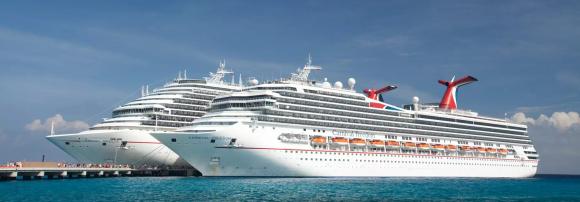 The Miami Herald recently helped to quantify the scale of the crew repatriation crisis aboard cruise ships around the world. They report that “two months after the cruise industry shut down amid repeated COVID-19 outbreaks on ships, more than 100,000 crew members remain trapped at sea with little reliable information about what will happen to them.”
The Miami Herald recently helped to quantify the scale of the crew repatriation crisis aboard cruise ships around the world. They report that “two months after the cruise industry shut down amid repeated COVID-19 outbreaks on ships, more than 100,000 crew members remain trapped at sea with little reliable information about what will happen to them.”
When the cruise lines first shut down on March 13, they anticipated being back in service within about a month, much like the SARS pandemic of 2002. Then on April 9, the U.S. Centers for Disease Control and Prevention banned cruising in U.S. waters through at least late July. The CDC also imposed tough new rules for sending crew home, effectively banning the use of public transportation for crews traveling to or from cruise ships. Other countries also imposed new and tough regulations for repatriation.
Now, for something completely different. The bright pink manta ray was first seen swimming in 2015, in the waters off Australia’s Lady Elliot Island, on the Great Barrier Reef. It has been seen only seven times since, making its most recent appearance last February when photographed by Kristian Laine.
Scientists have nicknamed the ray, Inspector Clouseau, for the detective in the Pink Panther movies. It is the only pink manta ray ever seen. They believe that the coloration is due to a genetic mutation in its skin pigment.
Scientists baffled by pink manta ray spotted on Great Barrier Reef | The Latest | 7NEWS
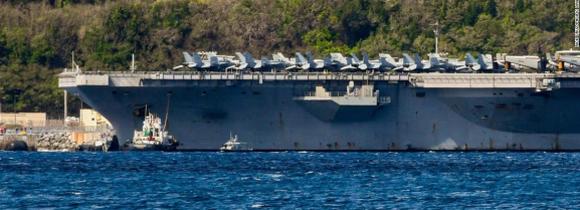 Yesterday, we posted about 5 sailors from the aircraft carrier USS Theodore Roosevelt who appeared to have contracted the coronavirus for a second time. That number has now risen to 13.
Yesterday, we posted about 5 sailors from the aircraft carrier USS Theodore Roosevelt who appeared to have contracted the coronavirus for a second time. That number has now risen to 13.
Politico reports that the 13 Covid-positive sailors have been removed from the ship and are back in isolation on U.S. Naval Base Guam, according to the officials.
“This week, a small number of TR Sailors who previously tested COVID positive and met rigorous recovery criteria have retested positive,” said Navy spokesperson Cmdr. Myers Vasquez. “These protocols resulted in a small number of close contacts who were also removed from the ship, quarantined and tested.
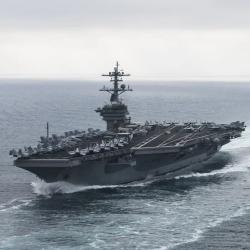 Five sailors on the aircraft carrier USS Theodore Roosevelt appear to have contracted the coronavirus for a second time and have been taken off the ship. The carrier is currently tied up in Guam after an outbreak of the virus infected over 1,100 sailors or almost a quarter of the ship’s crew.
Five sailors on the aircraft carrier USS Theodore Roosevelt appear to have contracted the coronavirus for a second time and have been taken off the ship. The carrier is currently tied up in Guam after an outbreak of the virus infected over 1,100 sailors or almost a quarter of the ship’s crew.
Time reports that all five sailors had previously tested positive and had gone through at least two weeks of isolation. As part of the process, they all had to test negative twice in a row, with the tests separated by at least a day or two before they were allowed to return to the ship.
 More than 20 cruise ships are departing Manila Bay to escape the wrath of Category 3 Typhoon Vongfong making landfall in the Philippines. Many of the cruise ships had been in the process of repatriating Filipino crew members, a process interrupted by the arrival of the typhoon.
More than 20 cruise ships are departing Manila Bay to escape the wrath of Category 3 Typhoon Vongfong making landfall in the Philippines. Many of the cruise ships had been in the process of repatriating Filipino crew members, a process interrupted by the arrival of the typhoon.
With the Center for Disease Control (CDC) “no sail orders” resulting from the coronavirus pandemic, cruise operators faced challenges in getting their crews home, as they were effectively banned from commercial transportation. Several cruise lines, including the two largest, Carnival and Royal Caribbean, decided, in addition to arranging charter flights, to use their company’s ships to repatriate some of their crews.
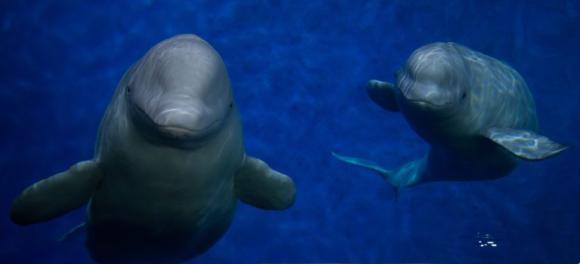 Almost a year ago, two beluga whales, Little White and Little Grey, traveled 6,000 miles from an aquarium in Shanghai around the globe to Iceland to a new home in the world’s first beluga whale sanctuary. If all goes well, the experience with these first two whales will become a model for rehoming 3,000 of belugas currently in captivity.
Almost a year ago, two beluga whales, Little White and Little Grey, traveled 6,000 miles from an aquarium in Shanghai around the globe to Iceland to a new home in the world’s first beluga whale sanctuary. If all goes well, the experience with these first two whales will become a model for rehoming 3,000 of belugas currently in captivity.
Little Grey and Little White, two 12-year-old female belugas, left behind their previous lives entertaining visitors at the Changfeng Ocean World and were flown across the globe in specially tailored containers. The whales, which each weigh about 900kg and are four meters long, then were taken by truck and ferry to the sanctuary at Klettsvik Bay at Heimaey, one of the Westman Islands off the south coast of Iceland.
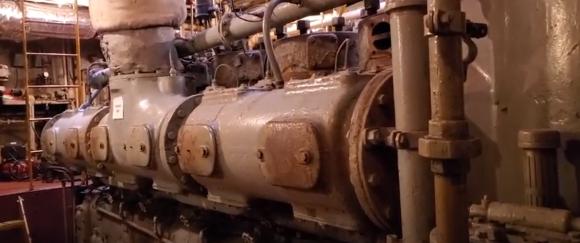 The historic tanker Mary A. Whalen is in dire need of parts to restore its diesel engine. A powerplant in Missouri has a compatible diesel. All that needs to be done is to raise the money to move the engine cross-country before the power plant needs to dispose of the engine. Arrangements had been made and the plans were set to make the transfer, but then the pandemic hit. Things became more complicated and a lot more expensive. Now time is running out.
The historic tanker Mary A. Whalen is in dire need of parts to restore its diesel engine. A powerplant in Missouri has a compatible diesel. All that needs to be done is to raise the money to move the engine cross-country before the power plant needs to dispose of the engine. Arrangements had been made and the plans were set to make the transfer, but then the pandemic hit. Things became more complicated and a lot more expensive. Now time is running out.
Mary A. Whalen is a coastal/harbor tanker built in 1938 and is one of the last of her type. The ship had a long and storied career and is listed on the National Register of Historic Places. The non-profit PortSide NewYork saved the tanker from the scrapper’s torch in 2005. Based on the Brooklyn waterfront, the ship has been the home of Portside’s nautical and community programming ever since.
